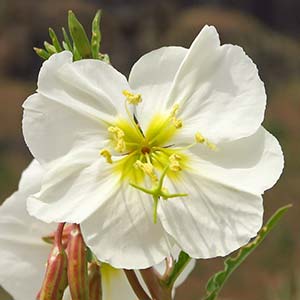Oenothera hartwegii
Oenothera pallida
Fendler evening primrose, Hartweg's sundrops
mountain evening primrose, pale evening-primrose, rockweed brush, white-stem evening primrose
1–many, erect to ascending, unbranched to densely branched, 4–60 cm.
erect or ascending, single to several from base, unbranched or many-branched throughout, 10–50(–70) cm.
0.3–6.5 × 0.04–1.2 cm, sometimes fascicles of small leaves 0.1–1.5 cm present in non-flowering axils;
petiole 0–0.2 cm;
blade elliptic, lanceolate, linear, or filiform to ovate or oblanceolate, usually not much reduced distally, proximalmost leaves sometimes obovate to spatulate, base attenuate to obtuse, truncate, or subcordate, sometimes clasping, margins entire or serrate, often undulate, apex acute.
cauline, rosette usually weakly developed or absent, at least during flowering, sometimes well developed, 1–5(–7.8) × 0.3–1(–1.5) cm;
petiole 0–2(–4.5) cm;
blade lanceolate, oblong, linear-lanceolate, or ovate, margins subentire or remotely denticulate, deeply sinuate-dentate, or pinnatifid, sometimes repand.
usually 1 per stem opening per day in afternoon or near sunset;
buds with free tips 0.5–6 mm;
floral tube 16–50(–60) mm, funnelform in distal 1/2 or less;
sepals 7–28 mm;
petals yellow, fading pale pinkish or pale purple, 10–35 mm;
filaments 4–13 mm, anthers 5–13 mm, pollen 85–100% fertile;
style 25–65(–75) mm, stigma yellow, quadrangular, usually exserted beyond anthers.
1–several opening per day near sunset;
buds nodding, weakly quadrangular, with free tips 0–2 mm;
floral tube 15–40 mm;
sepals 10–30 mm, not spotted;
petals white, fading pink to deep pink, broadly obovate or obcordate, (10–)15–25(–40) mm;
filaments 9–15 mm, anthers 3–10 mm;
style 25–55 mm, stigma exserted beyond anthers at anthesis.
6–40 × 2–4 mm, hard, promptly dehiscent throughout their length.
spreading to reflexed, straight to curved or contorted, cylindrical, obtusely 4-angled, tapering slightly from base to apex, 15–60 × 1.5–2.5 mm;
sessile.
obovoid, 1–2.5 mm.
numerous, in 1 row per locule, brownish with dark spots or black, narrowly obovoid, 1.5–2.2 mm.
= 14, 28.
Oenothera hartwegii
Oenothera pallida
Subspecies 5 (5 in the flora).
Oenothera hartwegii consists of five intergrading subspecies, which are generally locally common on rocky, sandy, gypsum, or limestone soil in arid to relatively mesic open areas, in southeastern Colorado, southwestern Kansas, western Oklahoma, Texas (except eastern part), New Mexico, southeastern and east-central Arizona, and in Mexico from Chihuahua, northern Coahuila, and northwestern Tamaulipas south to Aguascalientes. H. F. Towner (1977) found that O. hartwegii is self-incompatible and usually vespertine; two of the subspecies (filifolia and maccartii) open early in the afternoon and are pollinated both day and evening.
(Discussion copyrighted by Flora of North America; reprinted with permission.)
Subspecies 4 (4 in the flora).
Oenothera pallida is a poorly understood species currently subdivided into four subspecies (W. L. Wagner et al. 2007) that differ largely in aspect, leaf division, capsule configuration, and pubescence. The variation pattern is rather complex with almost no diagnostic character uniformly distinguishing any one of the subspecies. Instead, each of the subspecies, which are mostly geographically separated although there is some level of overlap, have diagnostic suites of characters that maintain their linkage some of the time, but break down across the geographic area of each so that no single character uniquely identifies it. Each subspecies is characterized by leaf, pubescence, and, often, habit features. The issues with the integrity and intergradations of the subspecies are discussed below.
Oenothera pallida has been determined to be self-incompatible (W. L. Wagner et al. 2007), but K. E. Theiss et al. (2010) determined that although most populations of subsp. pallida are self-incompatible, one near Salt Lake City is self-compatible.
(Discussion copyrighted by Flora of North America; reprinted with permission.)
1. Leaves (except proximalmost): blade base truncate or subcordate and clasping; plants densely pubescent with mixture of hair types, but always short-pilose and usually also hirtellous, sometimes also strigillose, especially on leaves, or glandular puberulent distally. | subsp. pubescens |
1. Leaves: blade base attenuate or obtuse; plants glabrous, sparsely strigillose, or glandular puberulent. | → 2 |
2. Plants usually glabrous throughout, sometimes glandular puberulent on distal parts, especially on ovary. | subsp. fendleri |
2. Plants strigillose and/or glandular puberulent, especially on distal parts. | → 3 |
3. Plants glandular puberulent throughout, more densely so on distal parts, sometimes also sparsely strigillose on ovary and leaves; leaf blades filiform to narrowly lanceolate. | subsp. filifolia |
3. Plants usually strigillose, rarely glandular puberulent; leaf blade narrowly lanceolate to oblanceolate, sometimes linear. | → 4 |
4. Leaf blades narrowly lanceolate, sometimes linear, margins entire or shallowly and sparsely serrulate, sometimes undulate; plants sparsely to densely strigillose throughout. | subsp. hartwegii |
4. Leaf blades usually narrowly lanceolate to lanceolate or oblanceolate, rarely linear, margins subentire or serrulate, usually crinkled-undulate; plants usually sparsely strigillose, sometimes glandular puberulent. | subsp. maccartii |
1. Herbs annual, sometimes perennial from a taproot, when perennial, sometimes with lateral roots producing adventitious shoots, strigillose throughout and villous distally, especially on flower parts. | subsp. trichocalyx |
1. Herbs perennial from a taproot and with lateral roots producing adventitious shoots, glabrous, strigillose, or sparsely villous. | → 2 |
2. Plants glabrous, sometimes strigillose, rarely sparsely villous; leaf blade margins usually subentire or remotely denticulate, rarely pinnatifid; capsules usually contorted to curved. | subsp. pallida |
2. Plants usually strigillose, rarely villous or glabrous; leaf blade margins shallowly sinuate-dentate or denticulate, or deeply sinuate-dentate to pinnatifid, rarely only dentate; capsules usually straight or curved, sometimes contorted. | → 3 |
3. Leaf blades (0.4–)0.7–1.5 cm wide, margins shallowly sinuate-dentate or denticulate. | subsp. latifolia |
3. Leaf blades 0.4–1(–1.5) cm wide, margins usually deeply sinuate-dentate to pinnatifid, rarely dentate only. | subsp. runcinata |
